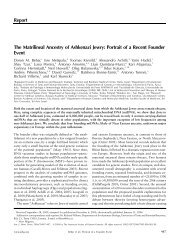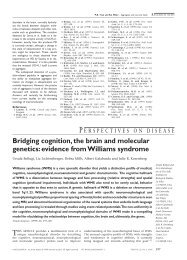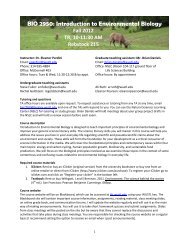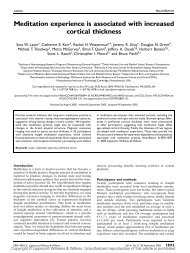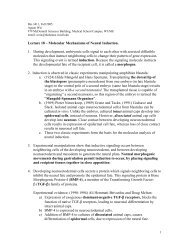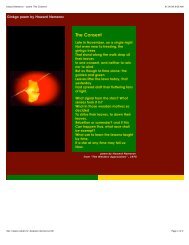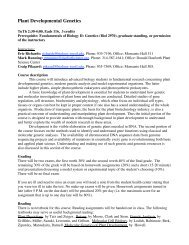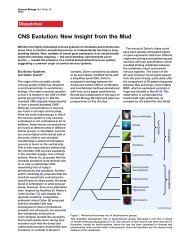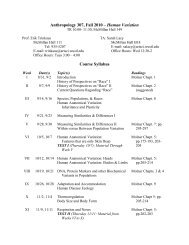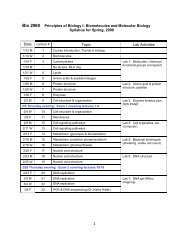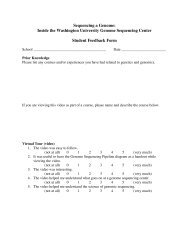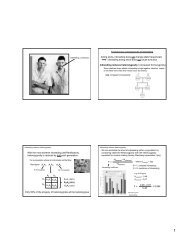IN MEMORIAM Pieter D. Nieuwkoop - Natural Sciences Learning ...
IN MEMORIAM Pieter D. Nieuwkoop - Natural Sciences Learning ...
IN MEMORIAM Pieter D. Nieuwkoop - Natural Sciences Learning ...
You also want an ePaper? Increase the reach of your titles
YUMPU automatically turns print PDFs into web optimized ePapers that Google loves.
2 In Memoriam: <strong>Pieter</strong> D. <strong>Nieuwkoop</strong><br />
nal. He considered this self-organization capacity a major analyzed further in Xenopus, where conflicting results ob-<br />
research problem for future experimental attention. His intain, such a requirement for vertical activation has been<br />
terest in neural induction continued throughout his life, taken seriously for many years by researchers of urodele<br />
especially with regard to the means by which the activating neural induction. In summary, <strong>Pieter</strong> <strong>Nieuwkoop</strong>’s contri-<br />
and transforming factors reach the responsive ectoderm butions to studies of neural induction have been major and<br />
cells to give the anteroposterior order of the neural plate. lasting, and the temporal aspects of his proposals, uniquely<br />
Whereas others pursued exclusive spatial interpretations<br />
such as double morphogen gradients, he pursued a largely<br />
emphasized by him, have still not been explored by others.<br />
temporal interpretation based on (1) the progressive movements<br />
of the inductive dorsal mesoderm under the ecto-<br />
Meso-endoderm Induction<br />
derm during gastrulation and (2) the changing competence In 1969 (a,b) <strong>Nieuwkoop</strong> made his second major contribuof<br />
the ectoderm. With regard to movements, the prechordal tion, the discovery and description of endo-mesoderm in-<br />
plate in the lead would neuralize all ectoderm under which duction in the amphibian blastula. He found this induction<br />
it passed. The chordamesoderm would follow thereafter and first in urodeles by surgically recombining vegetal hemi-<br />
transform (posteriorize) whatever neuralized ectoderm it sphere cells with animal hemisphere cells of the 2000-cell<br />
passed under, to an extent related to the duration of contact. blastula, after eliminating all prospective mesoderm includ-<br />
The posterior neural plate formed posterior structures be- ing the Spemann organizer. Neither the cap nor vegetal cells<br />
cause the chordamesoderm had passed under it for the lon- alone or in situ would differentiate mesoderm or pharyngeal<br />
gest time, hence exposing it to transforming agent for the endoderm. However, the recombinate made these tissues<br />
longest period. Anterior ectoderm near the animal pole, on and in some cases developed an embryoid with good axial<br />
the other hand, would form fore- and midbrain because it organization and a nervous system, a clear indication that<br />
received activator only from the prechordal plate and was the Spemann organizer had been restored. He and G. Ubbels<br />
never reached by the chordamesoderm. Intermediate neural (1972) showed by several means that it was the animal cap<br />
plate levels experienced intermediate durations of exposure cells that responded to inducers and the vegetal cells that<br />
to the transforming factor. Thus the plate gained its antero- released these inducers. E. Boterenbrood and <strong>Nieuwkoop</strong><br />
posterior organization. For <strong>Nieuwkoop</strong> the spatial distribu- (1973) then showed that the inductive vegetal cells were of<br />
tion of signals in the dorsal mesoderm was rather simple: two kinds: the majority lateroventral members inducing<br />
the prospective prechordal mesoderm was the main locus adjacent animal cap cells to form ventral meso-endoderm,<br />
of the activating agent and the chordamesoderm the main whereas the minority dorsal members induced adjacent cap<br />
locus of the transforming agent. Signals from these tissues cells to form dorsal meso-endoderm. The blastula vegetal<br />
reached the overlying ectoderm by a vertical path, inducing hemisphere as a whole carried a dorsoventral pattern that<br />
the midline of the neural plate, the future floor plate. Then, was inductively imprinted on the cell population of the<br />
according to him, signals spread laterally and anteriorly by equatorial level, generating at least two regions of meso-<br />
a propagation mechanism within the plane of the neural endoderm in the marginal zone. The dorsal region of this<br />
plate. zone was none other than the Spemann organizer, and hence<br />
With regard to the ectoderm’s changing competence, he the dorsal vegetal cells were ‘‘the organizer of the orgaconsidered<br />
the boundaries of the neural plate as set by the nizer.’’ Sudarwati and <strong>Nieuwkoop</strong> (1971) soon extended the<br />
cessation of the ectoderm’s competence at stage 12 to re- analysis to the anuran Xenopus, and hence meso-endoderm<br />
spond to activating signals slowly propagated in its tissue induction was seen as general to amphibia, and probably to<br />
plane and not set by the location of the low end of a morpho- most chordates. In the 1980s the ‘‘endo-’’ part of mesogen<br />
gradient. Such signals, he thought, continued to pass endoderm induction tended to be dropped by other research-<br />
through the ectoderm even after stage 12, despite its nonreers in the enthusiasm to study the formation of mesoderm<br />
sponsiveness, and B. Albers (1987), in her published thesis (especially muscle) by ectoderm treated with purified pro-<br />
work done under <strong>Pieter</strong>’s direction, supported this conclutein growth factors, but <strong>Nieuwkoop</strong> had emphasized from<br />
sion by grafting stage 10 gastrula ectoderm into the stage the beginning that pharyngeal endoderm was also induced,<br />
12 neural plate and showing that it was still neuralized. and hence ‘‘meso-endoderm induction’’ was the appropriate<br />
<strong>Nieuwkoop</strong> and Albers (1991) then showed that although term. So great has been the influence of <strong>Nieuwkoop</strong>’s work<br />
the competence toward activators was over by stage 12, on current studies of meso-endoderm inducers, regional<br />
the competence to respond to propagated transformation gene expression, and organizer formation that it seems ap-<br />
signals went on until stage 16. This analysis involved transpropriate to call the doral vegetal cells the ‘‘<strong>Nieuwkoop</strong><br />
plantation of prospective forebrain regions to posterior posi- Center.’’ This is the site of maternal components, localized<br />
tions in the neural plate and assessment of their extent of by cortical rotation and needed at the blastula stage for the<br />
posteriorization. In his last experimental publication, Nieu- induction of the Spemann organizer, the source of inductive<br />
wkoop and Koster (1995) concluded that neural induction signals in the gastrula stage.<br />
could only start by way of a vertically transmitted activat- <strong>Nieuwkoop</strong>, upon finding that mesoderm and pharyngeal<br />
ing signal, not a planar one, although planar propagated endoderm were derived exclusively from the animal cap<br />
signals had a role thereafter. Whereas this remains to be ectoderm, concluded that an induction was at work and not<br />
Copyright � 1997 by Academic Press. All rights of reproduction in any form reserved.



